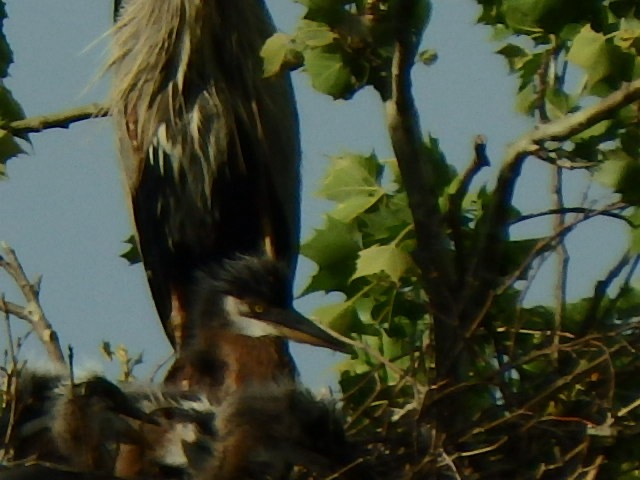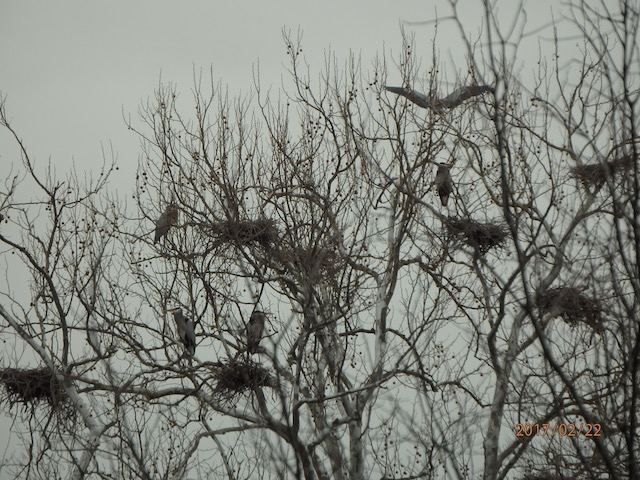Coexisting with Great Blue Herons
by Louise Flenner
Sometimes we can work together to provide for the preservation of birds and mitigate the effect of expanding human encroachment on their territory. I recently had a positive experience working with Parks and Rec Dept.in Columbia on their plan for a mountain bike trail at Gans Creek Recreation Area (GCRA).
When the City acquired the Crane property to build GCRA on the south side of town near Rock Bridge Memorial SP, they also acquired the breeding grounds of great blue herons. An active rookery had existed in the undisturbed natural area along Gans Creek for over an estimated 30 years. I became particularly interested in the rookery after seeing it for the first time. One might say I fell in love with it. I began to await the arrival of the herons every spring and would make frequent trips to the site beginning in mid-February to see when the migrating birds arrived. It seemed only natural to start keeping some data on the number of nests and number of birds that comprised the rookery. I started to bring interested people to help me count nests and birds. For the past 3 years, I have led a field trip to the rookery on March 15 to see and count nests and birds.
When the City first revealed their plan for the use of the property as a recreation area, I was appalled by the proximity of baseball fields and soccer fields to be built near the rookery. This led to meetings with the Parks and Rec planners to increase their awareness of the heron rookery and the need to preserve these important residents of the park. I shared with them the idea of creating a buffer zone that would protect an area around the nesting site from excessive human activity. An internet search led me to a blueprint for preserving heron rookeries in urban areas. The Washington State Fish and Wildlife conducted the study and outlined the guidelines for establishing buffer zones. I used this, along with my data and community support from others, including CAS members, who were also concerned about the herons to educate the planners on how to manage the area for sensitivity to the needs of the herons. Dee Dokken, former Conservation Chair of CAS, played a vital watchdog role throughout the years. Like many city park projects, plans change according to funding. Luckily, the baseball fields were never built as the University of Missouri joined with the city to use a part of land for a cross country race course. This led to the herons abandoning nest sites that were near the race course and moving closer together into a more compact site of trees farther from the cross country activity. It is now my conjecture that it wasn’t the activity of the races or people using the course that influenced the move, but the constant need for lawn mowing and sprinkler systems, particularly during the breeding season.
All of this history brings us back to the current proposed mountain bike trail. As soon as I learned that this was on the agenda, I contacted Gabe Huffington, head of Parks and Rec, about the trail’s impact on the herons. My approach was as a friend, not a foe. I have been an advocate of mountain biking for many years and I understand the use of single track trails. In fact, I could see that this might be the best recreational designation in the park for co-existing with the herons. There are no cheering crowds, night lights, motorized vehicles, mowers, sprinklers. We still needed a buffer zone for the herons during the breeding season. Gabe was familiar with this idea from our past discussions and very receptive to the idea of creating this buffer zone. I sent him a digital copy of the Washington State study and also a hard copy of the floristic assessment conducted in 2009 by Mike Currier as an initial survey upon purchase by the city. Currier had assessed the area before development during his tenure with Missouri State Parks as the GCRA is next to the Gans Creek Wild Area; Mike’s assessment in 2009 also worked towards keeping light and noise pollution away from Rock Bridge Memorial’s designated wild area. Gabe contacted Sarah Kendrick of the U.S. Fish and Wildlife Service-Migratory Birds Division to assess the heron rookery for a buffer zone and also involved the Missouri Dept. of Conservation in the planning phase of this project.
The proposed plan for GCRA is now open for public input. Sarah designated a buffer zone for the herons that extends 200 feet with Gans Creek as the center line. She recommends no trail building or race events during the breeding season. These guidelines have been incorporated into the City’s plan. At the public meeting, I met up with some former mountain bike friends who are spearheading the trail building. They are very interested in having a trail that does not disturb the herons and have asked me to visit the park with them to point out exactly where the rookery is located and to advise on their trail plans. They are hiring a professional trail building group who can build the trail in a short time during the time of year when the herons are not present.
Currently, I am optimistic that this plan could work as the best solution to preserve the rookery. There is much community support for the trails as the beginner trail is seen as a way for children to get involved in this outdoor sport. Time will tell if the great blue herons can continue to feel at home with this level of human activity. It has been a good experience in community cooperation. Fingers crossed.


